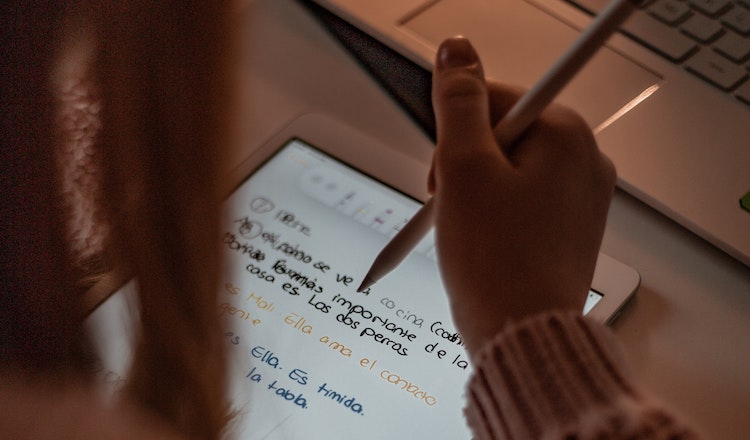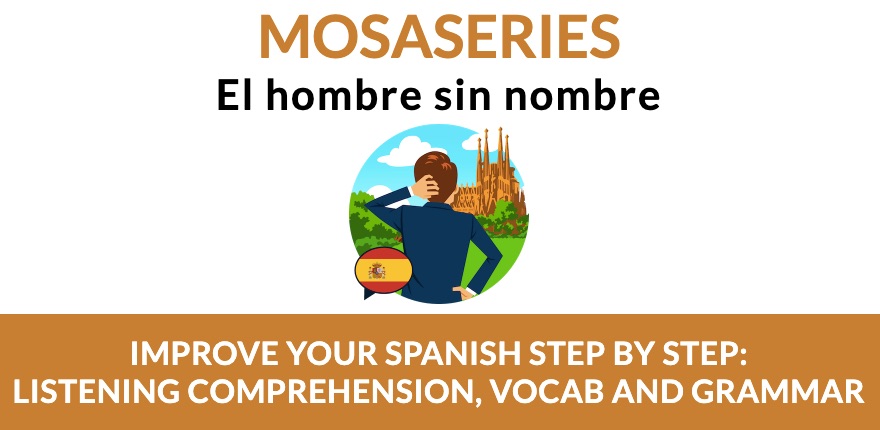If you want to speak Spanish, you’ll have to learn Spanish grammar at some point. Even if there are some similarities between Spanish and English vocabulary, grammar is very different in some regards. But don’t worry—we’re here to guide you and help you learn Spanish as quickly and efficiently as possible! With strong motivation, the right tools, and consistent practice, you’ll get the hang of Spanish grammar in no time.

When Should I Start to Learn Spanish Grammar?
This is a question that we get a lot from learners. We wrote an article about when and how to start diving into grammar, which you can read here.
Prioritize vocabulary and comprehension before grammar rules
As we like to say here at MosaLingua, it’s not necessary to know grammar rules by heart to speak a language. In general, we recommend you concentrate on vocabulary and feeling comfortable and confident in yourself and your pronunciation. Focus first on the easiest and most useful pieces: important words and phrases.
Integrate grammar slowly, as needed
Then, after a few weeks (or even months), you can start to look at Spanish grammar sheets. These will help you learn more about the rules and how things work. Remember, mastering grammar is strongly encouraged, but not required if you don’t feel the need. It’s not necessary to know everything off the top of your head. A native Spanish speaker will understand what you’re saying, even if you make a couple of grammatical mistakes! On the other hand, bad pronunciation or lack of vocabulary can present a major problem.
As we mentioned earlier, Spanish grammar and conjugation aren’t the easiest parts of the language. So take your time! Add them in little by little as your conversation and comprehension skills grow.
Mini Spanish Grammar Sheets
Feel free to skip around between these mini-lessons using the table of contents above, and come back to this article whenever you’re ready to learn about a new topic in Spanish grammar. ¡Vamos!
Building a sentence in Spanish
To make a sentence, you need to know word order, where to place the adjective, and how to conjugate the verb. For now, let’s focus on word order. Spanish sentence structure, like in every Latin-based language, follows this simple order: subject-verb-object.
So, you might say: “María es una mujer.” (María (S) is (V) a woman (O).)
Nouns and genders
Unlike in English, nouns in Spanish always have a gender: either feminine or masculine.
- A noun is probably feminine if it ends in: -a, -zón, -ción, -sión, -dad, -tad, -tud, -ez, -umbre, -triz, or -sis.
- A noun is probably masculine if it ends in: -o, -or, or -aje.
There are a few exceptions, like la foto, la mano, la moto, la radio, which are feminine. Seas, mountains, rivers, and other bodies of water are spelled and pronounced in the masculine form: Los Alpes, Los Pirineos, etc.
Thankfully, plurals are easy:
- if a word ends in a vowel, add an “-s”
- if a word ends in a consonant, add “-es” in the masculine and “-as” in the feminine.
According to these same rules, adjectives must agree in gender and number with the nouns they qualify. To use the example from before, we could say:
Elena es una mujer guapa. (Elena is a beautiful woman.)
Comparatives and superlatives
The parts of a comparison are also important to know. They add nuance to an idea and generally come before the adjective. For example:
- María es más alta que Mila. (María is taller than Mila.)
- Carmen es la mujer más alta de la familia. (Carmen is the tallest woman in the family.)
- Mila es menos alta que María. (Mila is shorter than María.)
- Elena es igual de alta que María. (Elena is the same height as María.)
- María es tan alta como Elena. (María is as tall as Elena.)
To express a heightened degree of a certain quality, Spanish uses “muy” + adjective or ísimo/ísima. For example:
- Muy guapo > guapísimo
- Muy grande > grandísimo
Start improving your Spanish today

Good news: we can help!
More good news: you can get started for free! With your free trial, you can test drive the most effective method for learning Spanish for the next 15 days!
Vocabulary flashcards, videos with subtitles, audiobooks, articles adapted to your level – with MosaLingua Premium (Web & Mobile), you’ll have access to all this and more. Get started right now. It’s free—and risk-free—to try!
Pronouns
Personal pronouns
To address an individual, use the expression “tú” in the singular and “vosotros” (masculine) or “vosotras” (feminine) in the plural form.
Example: “A vosotros os gusta la leche!” (You like milk!)
Reflexive pronouns: me, te, se, nos, os, se
These are used with pronominal verbs, in which case the infinitive is followed by -se. For instance: levantarse, despertarse, llamarse, vestirse, despertarse, etc. The reflexive pronoun must also agree with the conjugation of the verb.
Example: “Me llamo” (literally, “I call myself”), or “te llamas” (you call yourself).
Special case: the pronoun “se”
You’ll come across the word “se” pretty often in Spanish. When it’s not in the context of the verb “saber” (to know), it’s a pronoun. Personal, reflexive, reciprocal… The pronoun “se” has many uses!
To help you understand all its subtleties, our Spanish instructor Mirari explains all about this little word with big meaning in a video on Youtube. You can also watch it below. It’s in Spanish, so it’s great for practicing your listening skills. But feel free to turn on the subtitles in English or Spanish if you need them by clicking the gear icon in the bottom right corner:
Don’t forget to subscribe to our channel!
Possessive pronouns
These agree in gender and number with the noun they replace (just like adjectives):
- mío, mía, míos, mías — mine
- tuyo, tuya, tuyos, tuyas — yours (informal, singular)
- suyo, suya, suyos, suyas — his/hers/theirs/yours (formal, singular or plural)
- nuestro, nuestra, nuestros, nuestras — ours
- vuestro, vuestra, vuestros, vuestras — yours (plural)
Example: ¿Es vuestro este perro? Sí, es nuestro. (Is that your dog? Yes, it is ours.)
Demonstrative pronouns
These serve to designate a person or object and must also agree in gender and number, as well as indicate the subject’s location (near or far):
- este, estos, esta, estas (this – near the speaker)
- ese, esos, esa, esas (that – near the listener)
- aquel, aquellos, aquella, aquellas (that – away from both the listener and the speaker)
Example: Esta persona. (This person.)
Spanish conjugation
Word order is a fairly easy aspect of Spanish grammar, but verb conjugation takes a little more practice. If you spend time studying conjugation, you’ll be able to conjugate a verb into all the tenses you need.
Conjugation is a big piece of learning a language. But Spanish conjugation is really just about learning the endings for regular and irregular verbs, for all tenses and subjects. You’ll see, for a lot of situations, you only really need to learn the conjugations for the most common tenses of the most-used verbs in order to communicate.
And don’t forget: the other person will understand you just fine, even if you haven’t perfectly mastered Spanish grammar.
Irregular verbs
Just like in English, there are irregular verbs in Spanish! But they’re easier to learn than you might think. First of all, it’s not necessary to memorize them all—at first, just choose those you’ll use the most.
Here’s a list of 20 common irregular verbs, which you’ll also find in our article dedicated to Spanish irregular verbs. These are the verbs you should learn first! Start with the present indicative tense:
| Spanish Verb | English Translation | Present Indicative |
|---|---|---|
| caber | to fit | quepo, cabes, cabe, cabemos, cabéis caben |
| caer | to fall | caigo, caes, cae, caemos, caéis, caen |
| dar | to give | doy, das, da, damos, dais, dan |
| decir | to say | digo, dices, dice, decimos, decis, dicen |
| estar | to be | estoy, estás, está, estamos, estáis, estan |
| haber | to have, auxiliary to be | hé, has, ha, hemos, habéis, han |
| hacer | to do | hago, haces, hace, hacemos, hacéis, hacen |
| ir | to go | voy, vas, va, vamos, vais, van |
| oír | to hear | oigo, oyes, oye, oímos, oís, oyen |
| poder | to be able to | puedo, puedes, puede, podemos, podéis, pueden |
| poner | to put | pongo, pones, pone, ponemos, ponéis, ponen |
| querer | to want | quiero, quieres, quiere, queremos, queréis, quieren |
| saber | to know | sé, sabes, sabe, sabemos, sabéis, saben |
| salir | to leave | salgo, sales, sale, salimos, salis, salen |
| ser | to be | soy, eres, es, somos, sois, son |
| tener | to have | tengo, tienes, tiene, tenemos, tenéis, tienen |
| traer | to bring | traigo, traes, trae, traemos, traéis, traen |
| valer | to cost | valgo, vales, vale, valemos, valéis, valen |
| venir | to come | vengo, vienes, viene, venimos, venís, vienen |
| ver | to see | veo, ves, ve, vemos, veis, ven |
Other Ways to Learn Spanish Grammar
Movies, TV shows, and podcasts
One of the best ways to learn Spanish grammar is to use online resources. There are all kinds of tools out there to help familiarize you with the language while also having fun!
Watching a Spanish movie or TV show with Spanish subtitles is a great way to learn vocabulary and Spanish grammar in context. Spanish podcasts require more effort at first because they’re only audio, but they’re an excellent resource for understanding grammar through real-life situations.
MosaSeries: An original Spanish story
El Hombre Sin Nombre is a serial story developed by MosaLingua. It can help you learn the essential grammar rules while also improving your listening comprehension and vocabulary. MosaSeries stories are divided into several episodes to provide step-by-step lessons. You might learn new grammar rules without even noticing!
MosaLingua app
The MosaLingua app allows you to work on your Spanish grammar at any moment throughout the day. MosaLingua has designed and developed apps to help you learn Spanish grammar, pronunciation, and important expressions. Several features can be especially helpful with grammar:
- MosaLingua recordings: all the words and phrases available on MosaLingua apps have been recorded by native speakers to give you the most accurate pronunciation.
- Dialogues: these conversations are based on real-life situations, and are a great way to learn Spanish online. They will help you get used to Spanish accents, intonation, and grammar.
Want More Information?
You might be interested in these other articles:
What other topics of Spanish grammar are confusing to you? Let us know in the comments so that we can add more mini-lessons to this guide!






Wish to learn Spanish. Already speak French, English and Italian
Wish to add Spanish. am 74 years old and believe studying can delay Alzheimer
Well done, Bill! We are with you on that—learning new languages can have amazing health and brain benefits. Best of luck with your Spanish pursuits 🙂
Abbe